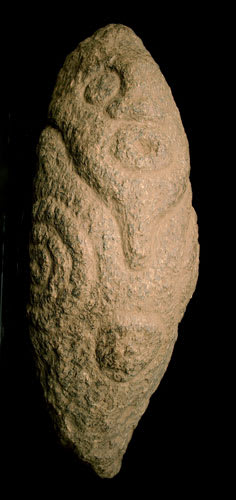Bakor/Ejagham Stone Monolith, 16th Century CE - 17th Century CE
Stone
5 x 18
CK.0459 (LSO)
Further images
Monoliths of this sort come from a restricted area in the Cross River region of eastern Nigeria. Known as “atal” to modern groups, they are believed to have been carved...
Monoliths of this sort come from a restricted area in the Cross River region of eastern Nigeria. Known as “atal” to modern groups, they are believed to have been carved and erected in the 16th to 17th centuries, and were still being worshipped and revered when European explorers penetrated the region in the early 20th century. All anthropomorphic monoliths come from a linguistically-defined area that covers only 900 square kilometers, hence the Bakor (language) appellation. The figures come in a variety of styles that seem to be socially localized; therefore, the permutation of open mouth, pointed chin, round eyes, and the groove separating neck and head seem to suggest that this particular figure came from a small area described by the village groups of Nta, Nde and Nselle. They are found primarily in abandoned villages, partially buried, and arranged with geometric precision in the market area and community playground. Recent groups are known to have painted and given offerings to them, although the antiquity of this tradition is uncertain. The archaeological background to these figures is somewhat uncertain, although they are believed to represent ancestors and legendary figures linked to memorable events. They may have a far longer history than is currently realized, for C14 samples from the site of Emangabe rendered a date of 200 AD, over a thousand years before the majority of figures so far studied. The current specimen is comparatively compact (many sculptures are over 100 cm tall) and elegantly pointed at both ends. The eyes are large and round, the nose a broad, upside-down “T”. The mouth is formed from a ring, and the chin/beard is pointed. The front and the sides of the figure are decorated with concentric circles (possibly arms and navel) and the dorsal aspect is unadorned. The quality of the carving is powerful and effective. The surface of the stone is unpolished yet the elevated portions of the carving retain a sheen that probably refers to a long tradition of libations and offerings being poured directly onto it. This is an important and impressive sculpture.





